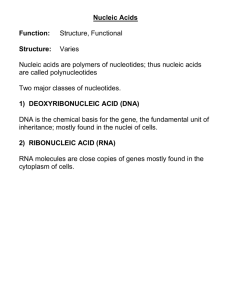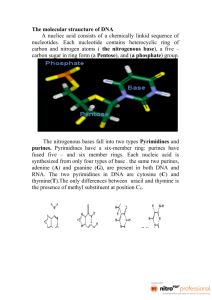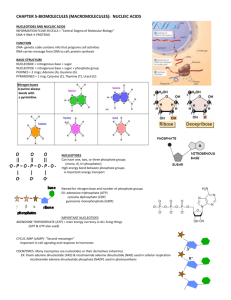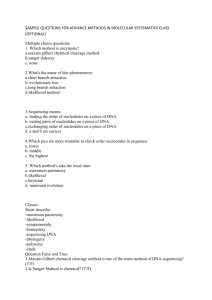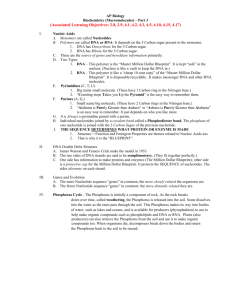The Structure of DNA
advertisement
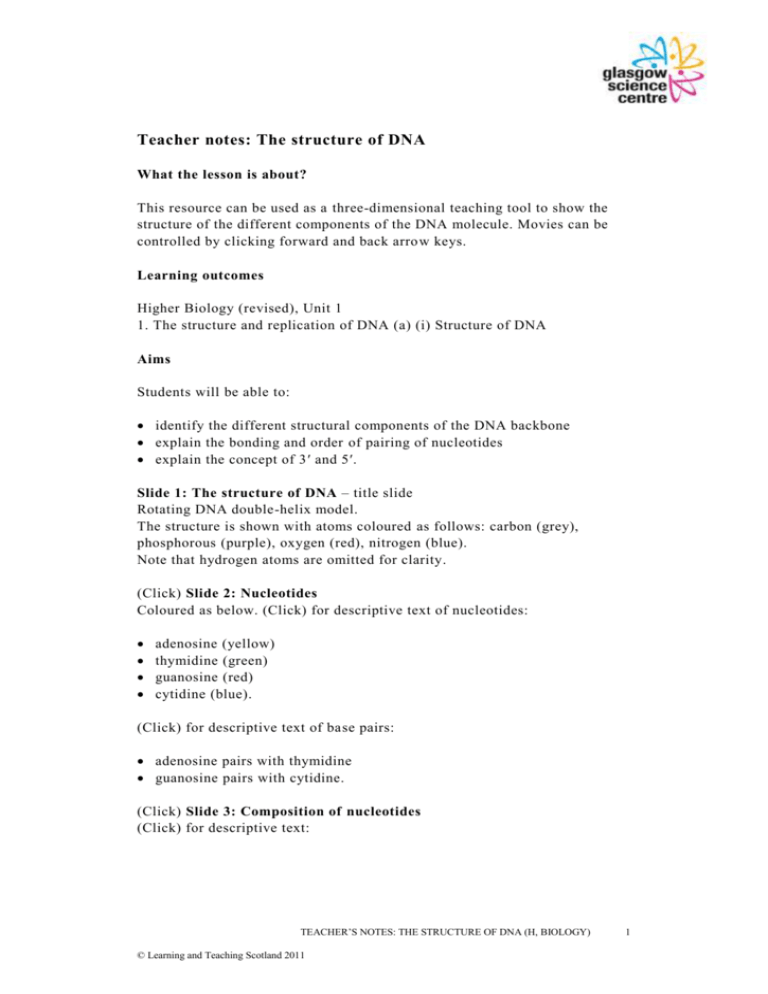
Teacher notes: The structure of DNA What the lesson is about? This resource can be used as a three-dimensional teaching tool to show the structure of the different components of the DNA molecule. Movies can be controlled by clicking forward and back arro w keys. Learning outcomes Higher Biology (revised), Unit 1 1. The structure and replication of DNA (a) (i) Structure of DNA Aims Students will be able to: identify the different structural components of the DNA backbone explain the bonding and order of pairing of nucleotides explain the concept of 3′ and 5′. Slide 1: The structure of DNA – title slide Rotating DNA double-helix model. The structure is shown with atoms coloured as follows: carbon (grey), phosphorous (purple), oxygen (red), nitrogen (blue). Note that hydrogen atoms are omitted for clarity. (Click) Slide 2: Nucleotides Coloured as below. (Click) for descriptive text of nucleotides: adenosine (yellow) thymidine (green) guanosine (red) cytidine (blue). (Click) for descriptive text of base pairs: adenosine pairs with thymidine guanosine pairs with cytidine. (Click) Slide 3: Composition of nucleotides (Click) for descriptive text: TEACHER’S NOTES: THE STRUCTURE OF DNA (H, BIOLOGY) © Learning and Teaching Scotland 2011 1 The three components of nucleotides are (Click): The base (coloured yellow). The name of the base differs from that of the nucleotide, ie when the base it is attached to the sugar phosphate, it is termed a nucleotide. The bases alone are termed adenine, thymine, guanine and cytosine. (This distinction is made in the interest of accuracy in the animations. It is not a learning outcome in the Higher course .) (Click). Sugar component (blue). The sugar is deoxy-ribose with a pentameric (five-membered ring). (Click) Phosphate (purple). (Click) Slide 4: Highlights the sugar–phosphate backbone (Click) Backbone is composed of alternating sugar and phosphate molecules. (Click) Sugar is joined to the phosphate group by ester bonds. This type of bonding is termed phospho-diester bonding. These are strong covalent bonds. (Click) The molecule is anti-parallel and you can see the pentameric ring structures point in opposite directions on each strand , highlighting this fact. (Click) Slide 5: Sugar–phosphate backbone assembles at 5′ and 3′ carbons DNA molecule unstacks and focuses on a single sugar -phosphate. (Click) to show numbered carbon atoms in the ribose ring. Highlight that the next sugar phosphate molecules join at the 5 ′ and 3′ carbons. (Click) to fill in adjacent groups. Can click forwards and backwards to highlight. (Click) Slide 6: Nucleotide structure DNA molecule unstacks to highlight different nucleotide structures. (Click) Groups nucleotides according to their bases as purines and pyrimidines. These are defined by their ring structures. The purine-containing nucleotides are guanosine and adenosine and the pyrimidine -containing nucleotides are cytidine and thymidine. Note the nucleotide names differ from the base names. (This distinction is made in the interest of accuracy in the animations. It is not a learning outcome in the Higher course.) (Click) to show the bonds between bases. (Click) Pairing occurs through hydrogen bonds. (Click) The G–C bonds are stronger as there are three such bonds. 2 TEACHER’S NOTES: THE STRUCTURE OF DNA (H, BIOLOGY) © Learning and Teaching Scotland 2011 (Click) The A–T bonds are weaker as there are two such bonds. (Click) Slide 7: Summary slide Students should be asked to draw a line diagram and annotate an ‘unwound’ double-stranded DNA molecule. Their model should include the labelled parts: sugar–phosphate backbone each base correctly paired: adenine (A) with thymine (T); cytosine (C) with guanine (G) labelling of one strand 5′ 3′ and the other 3′ 5′. TEACHER’S NOTES: THE STRUCTURE OF DNA (H, BIOLOGY) © Learning and Teaching Scotland 2011 3

